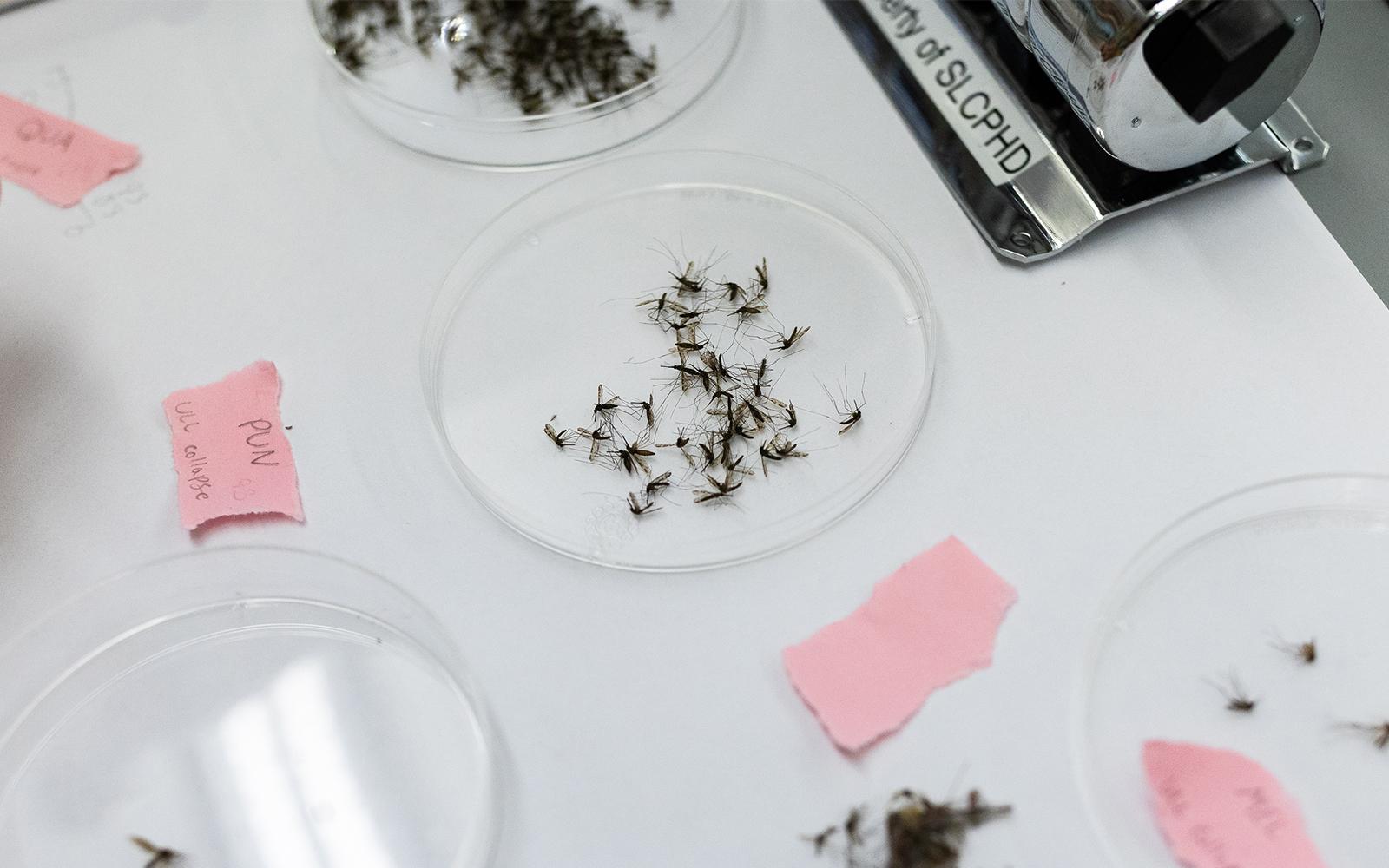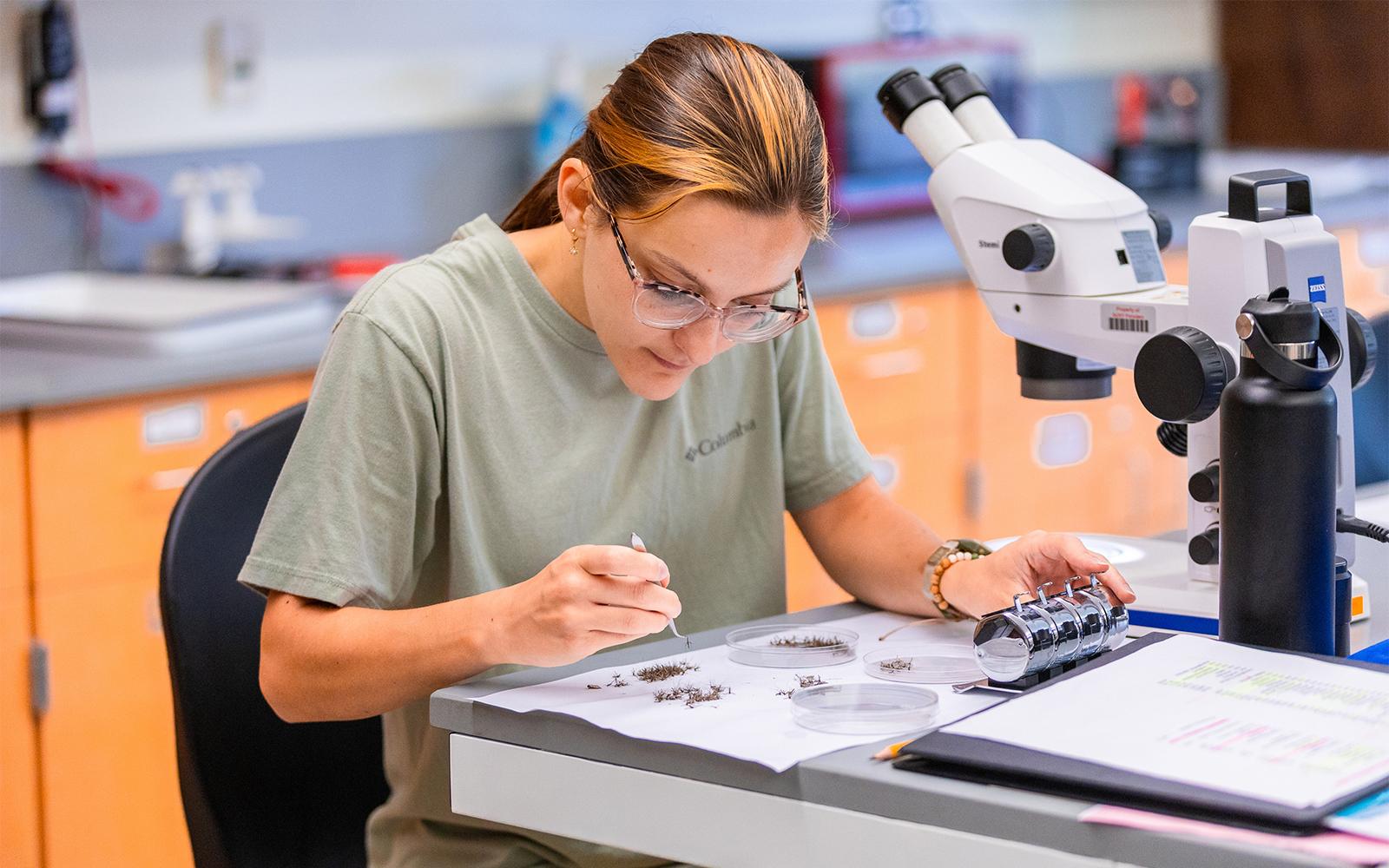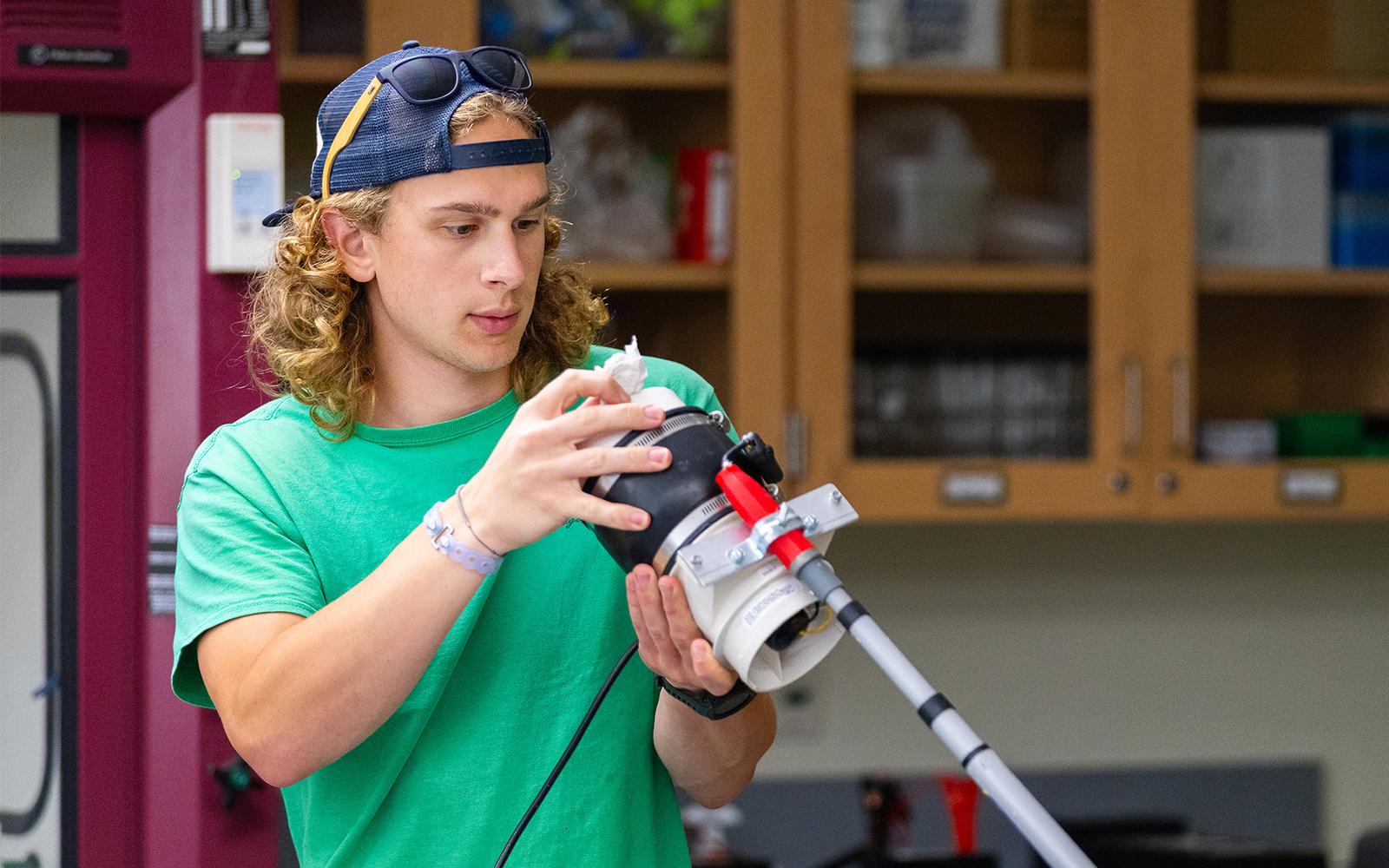SUNY Potsdam Students Join Mosquito Surveillance Effort to Protect North Country
Deep in the woods and wetlands of the North Country, just a short drive from SUNY Potsdam’s campus, Chase Bond ’26 uses a specialized vacuum to collect hundreds of buzzing, blood-seeking mosquitoes from a trap.
Bond is one of three SUNY Potsdam students working alongside Dr. Rob Snyder and Dr. Kate Cleary, with a team of students from Clarkson University and SUNY ESF. Together, they mastered the art of mosquito hunting this summer. By placing three different types of mosquito traps in three targeted regions of St. Lawrence County, they captured hundreds of mosquitoes as part of their integrated surveillance program for monitoring mosquito-borne zoonotic diseases—an important step in determining the most significant viral threats to wildlife and human populations in our region.
“When we developed the project, we wanted to assist the St. Lawrence County Department of Public Health with information they can use to make the public safer,” Snyder said, a longtime professor of biology at SUNY Potsdam, helping to lead the project.
West Nile Virus (WNV), Zika, and Eastern Equine Encephalitis (EEE) are some of the nasty viruses that mosquitoes can transmit to humans, with the latter being the catalyst for the research this summer.
“Triple E is a mosquito-borne viral disease that cycles naturally through birds, and the mosquitoes are vectoring between birds. Every so often, it will jump from the birds to a human or other mammal through the mosquito. It has been found in New York State for 30 years in a row. We have a vaccine for horses, but not for humans, and the fatality rate is very high. Even if you’re one of the lucky ones not to die, your health outcomes are not good,” Snyder said.

Although he admits it’s very rare for humans to contract the disease, with only one human case in New York state last year, a recent uptick in horse infections and deaths led to increased concern. In August 2024, the St. Lawrence County Public Health Department (SLCPH) issued a press release urging people to take precautions to avoid mosquito bites after two horses tested positive for EEE in Norwood and Brasher Falls. SUNY Potsdam alumna Erin Streiff ’16, who is now the director of public health for SLCPH, said that five horses were diagnosed with the virus in just two weeks last year.
“That prompted the New York State Department of Health (NYS DOH) to recommend we request an imminent threat to public health designation from the State Commissioner of Health,” said Streiff. “We reached out to contacts at our local universities in the county, and in addition to Clarkson and SUNY Potsdam, SUNY ESF also decided to work with us on the initiative.”
The Process
The project got underway on May 8, and after placing traps in the woods on their own and completing additional training with the New York State Department of Health focused on effective methods for trapping mosquitoes, the students hit the ground running.
Every Monday, the team visited three research sites in St. Lawrence County—the Upper and Lower Lakes Wildlife Management Area, the woods behind Clarkson University, and Brasher Falls State Forest—to deploy three types of mosquito traps. They began by using a vacuum to collect mosquitoes from a small black resting box, which serves as a shelter for the insects. Next, they set up a CDC (Centers for Disease Control) trap, baited with carbon dioxide from sublimating dry ice, a battery-powered light, and a fan to draw mosquitoes into a net. The final device, a gravid trap, consisted of a bucket filled with stagnant water designed to attract egg-laying female mosquitoes, and a fan then pulled them into a mesh container for collection.
Then it was back to the Stowell Hall lab, where SUNY Potsdam students Chase Bond '26, Ellie Barbolt '26, and Garrett J. O'Hara '27 worked alongside students from Clarkson University and SUNY ESF to sort the insects by species.
“We used visual analysis to first sort out the by-catch (non-mosquitoes), then we used microscopes and forceps to identify each mosquito to species, which is not as easy as it sounds,” Bond said. “We averaged about 1,000 mosquitoes per day; our record is 1,852 mosquitoes from one site, one night, but with all three sites, it could be upwards of 2,000 mosquitoes per day.”

Ellie Barbolt
As they sorted through hundreds of insects, separating them into about 35 separate pools based on their species, they were particularly interested in the Culiseta Melanura mosquito, which is a vector for EEE. So far, the deadly virus has not been discovered in their samples this year, although West Nile virus, a less deadly disease, was found in two of their sample pools.
“The students are incredibly fast at identifying the insects, and the State now knows more about the Arboviral diseases in the North Country than ever before,” Dr. Snyder said.
To preserve their samples, the students carefully packaged the mosquitoes with dry ice before shipping them out by Thursday, ensuring they arrive at the Department of Health’s lab in time for testing by the close of business Friday. The mosquitoes must remain extremely cold to protect the RNA (Ribonucleic acid) virus being tested, a far less stable molecule than DNA (Deoxyribonucleic acid)—so maintaining low temperatures is critical. To meet this need, the students have even learned to manufacture dry ice from scratch in the chemistry labs at Stowell Hall.
“The students are gaining much more than just research experience or a closer connection with a professor,” Cleary said. “They’re building relationships with the Department of Public Health, faculty at SUNY ESF, and the New York State Department of Health. It’s been an incredible opportunity for them to tap into a broader professional network that can help launch their careers after graduation.”
"I am glad to say I was a part of the first mosquito surveillance team of St. Lawrence County. This will continue to grow and improve, providing a great hands-on, real-life work experience for college students while benefiting the public health of people in the area.”

Financial Support
Snyder and Cleary applied fo a range of grants to fund this work. An initial $17,500 grant from the St. Lawrence River and Education Research Fund, coupled with an $8,500 Lougheed Center for Applied Learning (LoCAL) endowment, provided the core funding for the project—with the latter allowing Cleary and Snyder to purchase a machine for manufacturing dry ice right on campus, and purchase a specialized freezer to store it at -80 Celsius.
To support the three SUNY Potsdam students, a brand new Presidential Internship Program (PIP) was launched this summer. With a two-pronged approach, PIP creates both applied learning opportunities for students and strengthens community partnerships. The unique program connected 14 student interns with 11 organizations around the North Country during the summer of 2025—covering both internship credit costs and living expenses for the students. For the mosquito surveillance project, the St. Lawrence County Public Health Department sponsored O'Hara, Barbolt, and Bond, the three PIP interns at SUNY Potsdam.
“That was a big one for us. That program was a huge help,” said Dr. Snyder. “It didn’t just support the students by paying for their internship (credits), it gave them money for their cost of living. They weren’t like, ‘I have to run off to my next job,’ they could focus on their work.”
Bond said that on top of covering her tuition costs and providing a $4,000 stipend, she also applied for a separate LoCAL stipend, providing with an additional $2,250 to help offset her housing, gas, and other expenses.
“The funding provided by the PIP was essential for me to be able to participate in this internship. Doing research is a big part of my life and very important to me, but during the summer, I have to work to pay for school. The PIP funding provided me the luxury to be able to afford to continue my research through the summer,” Bond said.
The Big Picture
Although mosquito surveillance projects have taken place downstate in the past, this is the first time any research like this has even happened in St. Lawrence. Dr. Snyder said this was due in part to the logistical challenges of preserving the mosquito RNA in dry ice and getting it to the NYS DOH lab in time. But now, with a close eye on mosquito vectoring in the North Country, Streiff says the data will help keep people safe.
“Being able to identify vector species and the diseases they carry, as well as seasonal patterns in local mosquito populations, will help to provide accurate and timely education and awareness for the public, as well as help inform decision-making about potential abatement measures to prevent human infection with arboviral diseases like EEE as well as WNV,” she said.
The research project will continue in force next summer, with new PIP interns, and an expansive network of support from the partnering universities, the NYS Department of Health, and St. Lawrence County Public Health.
“It’s been an overwhelming success," said Snyder. “It’s amazing how great the students have been able to take on the challenges and push forward with this. And I think a lot of it has to do with the fact that they’re not here between three part-time jobs. They’ve been set up for success. It’s like they’re seasoned employees. I’m really proud of them.”
Article by Jason Hunter, photos by Jesstine Avadikian
